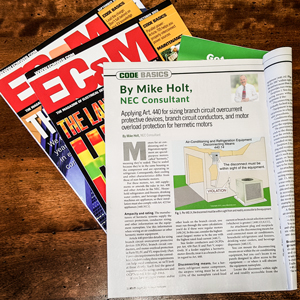
|
|
| Class 2 and 3 Circuits - Article 725 based on the 2014 NEC | |
|
|
|

By Mike Holt, NEC Consultant
If the power source is a listed Class 2 transformer or listed Class 2 power supply, or it’s in listed equipment marked to identify the Class 2 power source, you’ve got a Class 2 circuit between the power source and the connected Class 2 equipment [725.2]. Take that sentence, change the 2 to 3, and you define a Class 3 circuit. Class 2 circuits are rendered safe by limiting the power supply to 100 VA for circuits that operate at 30V or less, and the current to 5 mA for circuits over 30V [Chapter 9, Table 11(A)]. Class 2 circuits typically include wiring for low-energy, low-voltage loads such as thermostats, programmable controllers, and security systems. Class 2 also includes twisted-pair or coaxial cable that interconnects computers for Local Area Networks (LANs) and programmable controller I/O circuits [725.121(A)(3) and 725.121(A)(4)]. Class 3 circuits are used when the power demand exceeds 0.50 VA, but not more than 100 VA, for circuits over 30V [Chapter 9, Table 11(A)]. Power source (1) A listed Class 2 or Class 3 transformer. (2) A listed Class 2 or Class 3 power supply. (3) Equipment listed as a Class 2 or Class 3 power source. Exception 2 to 725.121(A)(3). Where each circuit has an energy level at or below the limits established in Chapter 9, Table 11(A) and Table 11(B), the equipment doesn’t need to be listed as a Class 2 or Class 3 power transformer, power supply, or power source. (4) Listed information technology equipment. (5) A dry cell battery rated 30V or less (for a Class 2 circuit). Equipment supplying Class 2 or Class 3 circuits must be marked to indicate each circuit that’s a Class 2 or Class 3 circuit [725.124]. This requirement means that the power source must be marked but not the raceways, cables, or fittings containing the Class 2 or 3 circuits. Wiring methods Conductors and equipment on the supply side of the Class 2 or Class 3 power source must be installed per Chapters 1 through 4 [725.127]. On the load side, Class 2 or Class 3 circuits can also use a Chapter 3 wiring method [725.130(A)]. Class 2 and Class 3 circuits can be reclassified as a Class 1 circuit if the Class 2 and Class 3 equipment markings required by 725.124 are eliminated and the entire circuit is installed using a Chapter 3 wiring method per Part II of Article 725 for Class 1 circuits. But then they are no longer Class 2 or Class 3 circuits, regardless of their continued connection to a Class 2 or Class 3 power source [725.130(A) Ex 2]. Class 2 and Class 3 circuit conductors must be of the type listed and marked per 725.179. Install them per 725.133 and 725.154 [725.130(B)]. Installation of Class 2, Class 3, and PLTC cables must comply with 725.135(A) through (M). Some highlights: (A) Class 2, Class 3, and PLTC cables installed in buildings must be listed. (C) Plenum rated Class 2 or Class 3 cables are permitted in plenum spaces as described in 300.22(C)(1) through (6). (H) Cables installed in cable trays outdoors must be Type PLTC. There are several other types for cable trays indoors. Separation from power conductors
Different circuits (A) Class 2 circuit conductors can be in the same cable, cable routing assembly, enclosure, or raceway as other Class 2 circuit conductors. Same thing for Class 3 conductors with other Class 3 conductors. (C) Class 2 conductors can be within the same cable, cable routing assembly, enclosure, or raceway as Class 3 circuit conductors, if insulation of the Class 2 circuit conductors is at least that required for Class 3 circuits. (D)(1) Class 2 and Class 3 circuit conductors can be within the same cables as communications circuits in listed communications cables in which case they’re classified as communications circuits and must be installed per Article 800. A common application of this requirement is when a single communications cable is used for both voice communications and data. Note that listed Class 2 cables have an insulation rating of at least 150V insulation [725.179(G)], whereas listed communications cables have a voltage rating of at least 300V [800.179]. (E) Class 2 or Class 3 jacketed cables can be in the same enclosure, cable tray, raceway, or cable routing assembly as jacketed cables of any of the following: (F) Audio output circuits [640.9(C)] using Class 2 or Class 3 wiring methods in compliance with 725.136 and 725.154 aren’t permitted in any cable routing assembly, raceway, or cable with Class 2 or Class 3 conductors or cables. But why? The concern is that a fault from audio amplifier circuits to a Class 2 and Class 3 circuit has the potential of creating a hazard by disrupting the operation of alarm systems and remote-control circuits for safety-control equipment. Support Exposed cables must be supported by the structural components of the building such that the cable won’t be damaged by normal building use. Cables must be secured by straps, staples, hangers, or similar fittings designed and installed in a manner that won’t damage the cable [725.24]. Listing and marking (A) Types CL2P and CL3P. Types CL2P and CL3P plenum cable are listed as being suitable for use in plenum space and listed as having adequate fire-resistance and low-smoke producing characteristics. (G) Class 2 cables must have a voltage rating not less than 150V, and Class 3 cables must have a voltage rating not less than 300V. (K) Voltage ratings can’t be marked on the cable. Why? Because voltage markings on cables may suggest the cables are suitable for Class 1 or electric power and light applications, but they aren’t. Avoiding problems
|
|||
|
|
| Visit: Exam Preparation | Continuing Education | Code Products | Newsletters | and more | |||
|
|||
|
|
|||||||||||||
